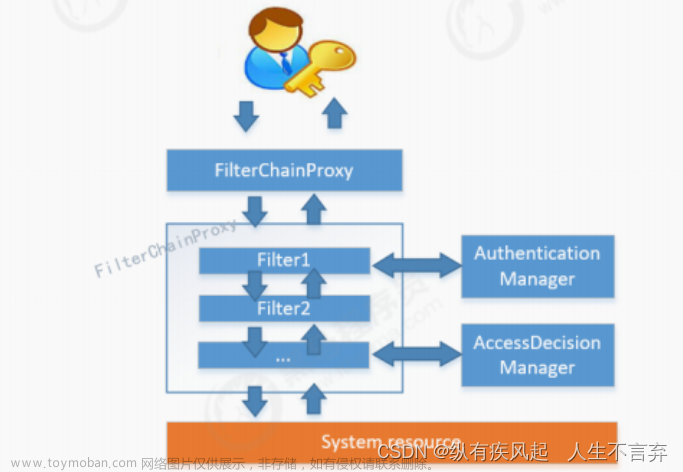用户应该分为三类:
1、普通用户(user):只允许登录前台小程序端并进行基本的操作、不能进行后台管理系统的任何操作。
2、店铺管理员(admin):允许管理店铺的栏目CRUD操作、商品CRUD操作、评论的查看与删除、查看店铺的销售情况等。
3、超级管理员(super):允许进行店铺管理和用户管理等操作、能查看系统的用户数和店铺数等基本统计。
具体实现
- 创建vue实例的时候将vue-router挂载,但这个时候vue-router挂载一些登录或者不用权限的公用的页面。
- 当用户登录后,获取用户roles,将roles和路由表每个页面的需要的权限作比较,生成最终用户可访问的路由表。
- 调用router.addRoutes(store.getters.addRouters)添加用户可访问的路由。
- 使用vuex管理路由表,根据vuex中可访问的路由渲染侧边栏组件。
代码层面:
1. 普通用户登录拒绝访问后端:

vue前端:
//用户登录获取token
login({ commit }, userInfo) {
const { phone, userPassword } = userInfo
return new Promise((resolve, reject) => {
login({ phone: phone.trim(), userPassword: userPassword.trim(),method: 1 }).then(response => {
//method 为一时代表是登录后台管理系统
const { data } = response
commit('SET_TOKEN', data.token)
setToken(data.token)
resolve()
}).catch(error => {
reject(error)
})
})
},
controller:
@PostMapping("/login")
public Result login(@RequestBody User user){
if(user.getMethod() == 1){ //为后台发出的登录请求,需要检验权限
String roles = userService.findUserByPhone(user.getPhone()).getRoles();
if(roles.equals("user")){ //普通用户,阻止登录后台
return Result.error().message("您没有足够的权限");
}
}
......省略了其它登录处理代码
2. admin(店铺管理员) 与 super(超级管理员) 不同身份登录能提供不同路由
1.后端返回的用户对象(必须携带roles字段):

2. vue-element-admin处理:
vue-element-admin登录并改变路由的开始:
import router from './router'
import store from './store'
import { Message } from 'element-ui'
import NProgress from 'nprogress' // progress bar
import 'nprogress/nprogress.css' // progress bar style
import { getToken } from '@/utils/auth' // get token from cookie
import getPageTitle from '@/utils/get-page-title'
NProgress.configure({ showSpinner: false }) // NProgress Configuration
//白名单
const whiteList = ['/login'] // no redirect whitelist
router.beforeEach(async(to, from, next) => {
// start progress bar
NProgress.start()
// set page title
document.title = getPageTitle(to.meta.title)
//获取token
// determine whether the user has logged in
const hasToken = getToken()
if (hasToken) {
//是否为登录
if (to.path === '/login') {
//去首页
next({ path: '/' })
NProgress.done()
} else {
//从vuex中获取权限
const hasRoles = store.getters.roles && store.getters.roles.length > 0
if (hasRoles) { //如果存在则放行
next()
} else {
try {
//roles 必须是一个数组
//获取用户信息和权限信息,存到vuex中
const { roles } = await store.dispatch('user/getInfo')
//生产路由数据
const accessRoutes = await store.dispatch('permission/generateRoutes', store.getters.roles)
//const accessRoutes = []
// dynamically add accessible routes
router.addRoutes(accessRoutes)
var tempRoutes = router.options.routes.slice(0,3).concat(accessRoutes); //将原路由侧边栏显示截取为初始三个(作者其实不支持这样)
router.options.routes = tempRoutes; //将路由添加到侧边栏(作者其实不支持这样)
// hack method to ensure that addRoutes is complete
// set the replace: true, so the navigation will not leave a history record
next({ ...to, replace: true })
} catch (error) {
// remove token and go to login page to re-login
await store.dispatch('user/resetToken')
Message.error(error || 'Has Error')
//next(`/login?redirect=${to.path}`)
next({ path: '/' })
NProgress.done()
}
}
}
} else {
/* has no token*/
if (whiteList.indexOf(to.path) !== -1) {
// in the free login whitelist, go directly
next()
} else {
// other pages that do not have permission to access are redirected to the login page.
next(`/login?redirect=${to.path}`)
NProgress.done()
}
}
})
router.afterEach(() => {
// finish progress bar
NProgress.done()
})
关键的处理函数(getInfo、generateRoutes)在store/文件目录下:
store/modules/permission.js:
const actions = {
generateRoutes({ commit }, roles) {
return new Promise(resolve => {
//存的是有权限的路由,是一个数组
let accessedRoutes
if (roles.includes('admin')) {
accessedRoutes = filterAsyncRoutes(asyncRoutes, roles)
} else {
accessedRoutes = filterAsyncRoutes(asyncRoutes, roles)
}
//commit('SET_ROUTES', accessedRoutes)
resolve(accessedRoutes)
})
}
}
......部分代码
store/modules/user.js:
//获取用户信息
getInfo({ commit, state }) {
return new Promise((resolve, reject) => {
//调用api/user里面的接口
getInfo(state.token).then(response => {
const { data } = response
if (!data) {
return reject('Verification failed, please Login again.')
}
const user = data.user
//console.log(user);
commit('SET_NAME', user.username)
commit('SET_AVATAR', user.headImg)
var temp_roles = [user.roles]; //vue-element-admin里面roles必须为数组
//console.log(temp_roles);
commit('SET_ROLES', temp_roles) //设置权限
resolve(data)
}).catch(error => {
reject(error)
})
})
},
......部分代码
router/index.js
import Vue from 'vue'
import Router from 'vue-router'
Vue.use(Router)
/* Layout */
import Layout from '@/layout'
/**
* Note: sub-menu only appear when route children.length >= 1
* Detail see: https://panjiachen.github.io/vue-element-admin-site/guide/essentials/router-and-nav.html
*
* hidden: true if set true, item will not show in the sidebar(default is false)
* alwaysShow: true if set true, will always show the root menu
* if not set alwaysShow, when item has more than one children route,
* it will becomes nested mode, otherwise not show the root menu
* redirect: noRedirect if set noRedirect will no redirect in the breadcrumb
* name:'router-name' the name is used by <keep-alive> (must set!!!)
* meta : {
roles: ['admin','editor'] control the page roles (you can set multiple roles)
title: 'title' the name show in sidebar and breadcrumb (recommend set)
icon: 'svg-name'/'el-icon-x' the icon show in the sidebar
breadcrumb: false if set false, the item will hidden in breadcrumb(default is true)
activeMenu: '/example/list' if set path, the sidebar will highlight the path you set
}
*/
/**
* constantRoutes
* a base page that does not have permission requirements
* all roles can be accessed
* 不需要权限就可以访问的路由
*/
export const constantRoutes = [
{
path: '/login',
component: () => import('@/views/login/index'), // “@”指的是src目录
hidden: true
},
{
path: '/404',
component: () => import('@/views/404'),
hidden: true
},
{//侧边栏主页路由
path: '/',
component: Layout,
redirect: '/dashboard',
children: [{
path: 'dashboard',
name: 'Dashboard',
component: () => import('@/views/dashboard/index'),
meta: { title: '主页', icon: 'dashboard' }
}],
}
]
//异步挂载的路由
//动态需要根据权限加载的路由表
export const asyncRoutes = [
{//侧边栏用户管理页路由
path: '/user',
component: Layout,
redirect: '/user',
children: [{
path: 'user',
name: 'User',
component: () => import('@/views/user/user'),
meta: { title: '用户管理', icon: 'user', roles: ['super'] }
}]
},
{//侧边栏店铺管理页路由
path: '/store',
component: Layout,
redirect: '/store',
children: [{
path: 'store',
name: 'Store',
component: () => import('@/views/store/store'),
meta: { title: '店铺管理', icon: 'shopping', roles: ['super'] }
}]
},
{//侧边栏发布管理页路由
path: '/commondity',
component: Layout,
redirect: '/commondity/column',
name: 'Commodity',
meta: { title: '发布管理', icon: 'edit',roles: ['admin']},
children: [
{
path: 'column',
name: 'Column',
component: () => import('@/views/column/column'),
meta: { title: '栏目管理', icon: 'list',roles: ['admin'] }
},{
path: 'product',
name: 'Product',
component: () => import('@/views/product/product'),
meta: { title: '商品管理', icon: 'money',roles: ['admin'] }
},
]
},
{//侧边栏订单管理页路由
path: '/order',
component: Layout,
redirect: '/order/order',
name: 'Order',
meta: { title: '订单管理', icon: 'clipboard',roles: ['admin']},
children: [
{
path: 'history_order',
name: 'history_Order',
component: () => import('@/views/order/order'),
meta: { title: '历史订单管理', icon: 'skill',roles: ['admin'] }
},{
path: 'receive_order',
name: 'Receive_order',
component: () => import('@/views/receive_order/receive_order'),
meta: { title: '接单管理', icon: 'people',roles: ['admin'] }
},
]
},
{//侧边栏评论管理页路由
path: '/comment',
component: Layout,
redirect: '/comment',
children: [{
path: 'comment',
name: 'Comment',
component: () => import('@/views/comment/comment'),
meta: { title: '评论管理', icon: 'message',roles: ['admin'] }
}]
},
{
path: 'external-link',
component: Layout,
children: [
{
path: 'https://gitee.com/x_y_king/master-goose',
meta: { title: '项目地址', icon: 'link'}
}
]
},
{ path: '*', redirect: '/404', hidden: true }
];
const createRouter = () => new Router({
// mode: 'history', // require service support
scrollBehavior: () => ({ y: 0 }),
routes: constantRoutes
})
const router = createRouter()
// Detail see: https://github.com/vuejs/vue-router/issues/1234#issuecomment-357941465
export function resetRouter() {
const newRouter = createRouter()
router.matcher = newRouter.matcher // reset router
}
export default router
3. 可以参考B站视频:
B站—vue-element-admin权限验证流程讲解
vue后台管理不同权限路由实现方式:
通过获取当前用户的权限去比对路由表,生成当前用户具有的权限可访问的路由表,通过
router.addRoutes动态挂载到router上。文章来源:https://www.toymoban.com/news/detail-800882.html
权限控制的主体思路,前端会有一份路由表,它表示了每一个路由可访问的权限。当用户登录之后,通过 token 获取用户的 role ,动态根据用户的 role 算出其对应有权限的路由,再通过
router.addRoutes动态挂载路由。但这些控制都只是页面级的,说白了前端再怎么做权限控制都不是绝对安全的,后端的权限验证是逃不掉的。现在就是前端来控制页面级的权限,不同权限的用户显示不同的侧边栏和限制其所能进入的页面(也做了少许按钮级别的权限控制),后端则会验证每一个涉及请求的操作,验证其是否有该操作的权限,每一个后台的请求不管是 get 还是 post 都会让前端在请求header里面携带用户的 token,后端会根据该 token 来验证用户是否有权限执行该操作。若没有权限则抛出一个对应的状态码,前端检测到该状态码,做出相对应的操作。文章来源地址https://www.toymoban.com/news/detail-800882.html
到了这里,关于vue-element-adminn实现权限管理(后端只控制权限roles)的文章就介绍完了。如果您还想了解更多内容,请在右上角搜索TOY模板网以前的文章或继续浏览下面的相关文章,希望大家以后多多支持TOY模板网!







![[VUE学习]权限管理系统前端vue实现8-右上角用户头像显示实现](https://imgs.yssmx.com/Uploads/2024/02/541121-1.png)



